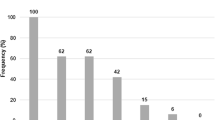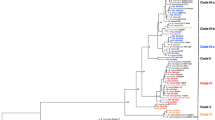Abstract
The presence of cytotoxin K (cytK), nonhemolytic (NHE), and hemolytic (HBL) enterotoxin genes was investigated in 74 Bacillus thuringiensis strains recovered from the intestines of wild mammals from northeast Poland, using polymerase chain reaction amplification and Southern hybridization. All the isolates harbored genes coding for toxin(s) that could cause diarrhea. The B. thuringiensis strains containing the nhe genes were found more frequently (nheA 100%, nheB 77%, nheC 96%) than those with the hblACD (74%) and cytK (73%) genes. The presence/absence of the nheA, hblA, and cytK genes was confirmed in all of the B. thuringiensis strains by Southern hybridization. Interestingly, these experiments also indicated that the nheA locus is located on a more variable chromosome region compared with hblA and, to a lesser degree, cytK. Detection of the 41-kDa component of NHE enterotoxin by the TECRA assay revealed various protein levels by B. thuringiensis strains. These results indicate the existence of environmental B. thuringiensis strains bearing the potential virulence arsenal for the production of diarrheal toxins, and emphasize the importance of small animals in the spread of B. cereus–like enterotoxin genes in nature. However, further investigation is needed to clarify any possible involvement of environmental B. thuringiensis strains in human health issues.



Similar content being viewed by others
References
Agata, N, Masashi, M, Ohta, M, Suwan, S, Ohtani, I, Isobe, M (1994) A novel dodecadepsipeptide, cereulide, isolated from Bacillus cereus causes vacuole formation in Hep-2 cells. FEMS Microbiol Lett 121: 31–34
Aronson, AI, Shai, Y (2001) Why Bacillus thuringiensis insecticidal toxins are so effective: unique features of their mode of action. FEMS Microbiol Lett 195: 1–8
Ash, C, Collins, MD (1992) Comparative analysis of 23S ribosomal RNA gene sequences of Bacillus anthracis and emetic Bacillus cereus determined by PCR-direct sequencing. FEMS Microbiol Lett 94: 75–80
Beecher, DJ, Schoeni, JL, Wong, ACL (1995) Enterotoxic activity of hemolysin BL from Bacillus cereus. Infect Immun 63: 4423–4428
Bickley, J, Owen, RJ (1995) Preparation of bacterial genomic DNA. In: Howard J, Whitecombe DM (Eds.) Diagnostic Bacteriology Protocols, Humana Press, Totowa, NJ, pp 141–147
Bourque, SN, Valero, JR, Lavoie, MC, Levesque, RC (1995) Comparative analysis of the 16S-23S ribosomal intergenic spacer sequences of Bacillus thuringiensis strains and subspecies and of closely related species. Appl Environ Microbiol 61: 1623–1626
Carlson, CR, Johansen, T, Kolstø, A-B (1996) The chromosome map of Bacillus thuringiensis subsp. canadensis HD224 is highly similar to that of Bacillus cereus ATCC 14579. FEMS Microbiol Lett 141: 163–167
Damgaard, PH, Larsen, HD, Hansen, BM, Bresciani, J, Jørgensen, K (1996) Enterotoxin-producing strains of Bacillus thuringiensis isolated from food. Lett Appl Microbiol 23: 146–150
Dierick, K, Van Coillie, E, Swiecicka, I, Meyfroidt, G, Devlieger, H, Meulemans, A, et al. (2005) Fatal family outbreak of Bacillus cereus—associated food poisoning. J Clin Microbiol 43: 4277–4279
Drobniewski, FA (1993) Bacillus cereus and related species. Clin Microbiol Rev 6: 324–338
Fagerlund, A, Ween, O, Lund, T, Hardy, SP, Granum, PE (2004) Genetic and functional analysis of the cytK family of genes in Bacillus cereus. Microbiology 150: 2689–2697
Gaviria Rivera, AM, Granum, PE, Priest, FG (2000) Common occurrence of enterotoxin genes and enterotoxicity in Bacillus thuringiensis. FEMS Microbiol Lett 190: 151–155
Granum, PE, Lund, T (1997) Bacillus cereus and its food poisoning toxins. FEMS Microbiol Lett 157: 223–228
Granum, PE, O'Sullivan, K, Lund, T (1999) The sequence of the non-haemolytic enterotoxin operon from Bacillus cereus. FEMS Microbiol Lett 177: 225–229
Granum, PE (2001) Bacillus cereus. In: Doyle, MP (Ed.) Food Microbiology: Fundamentals and Frontiers, ASM Press, Herndon, VA, pp 373–381
Guinebretière, M-H, Broussolle, V, Nguyen-The Ch (2002) Enterotoxigenic profiles of food-poisoning and food-borne Bacillus cereus strains. J Clin Microbiol 40: 3053–3056
Hansen, BM, Hendriksen, NB (2001) Detection of enterotoxic Bacillus cereus and Bacillus thuringiensis strains by PCR analysis. Appl Environ Microbiol 67: 185–189
Helgason, E, Okstad, OA, Caugant, DA, Johansen, HA, Fouet, A, Mock, M, Hegna, I, Kolstø, A-B (2000) Bacillus anthracis, Bacillus cereus, and Bacillus thuringiensis—one species on the basis of genetic evidence. Appl Environ Microbiol 6: 2627–2630
Jensen, GB, Larsen, P, Jacobsen, BL, Madsen, B, Smidt, L, Andrup, L (2002) Bacillus thuringiensis in fecal samples from greenhouses workers after exposure to B. thuringiensis-based pesticides. Appl Environ Microbiol 68: 4900–4905
Kotiranta, A, Lounatmaa, K, Haapasalo, M (2000) Epidemiology and pathogenesis of Bacillus cereus infections. Microbes Infect 2: 189–198
Lindbäck, T, Fagerlund, A, Rødland, S, Granum, PE (2004) Characterisation of the Bacillus cereus Nhe enterotoxin. Microbiology 150: 3959–3967
Lund, T, Granum, PE (1996) Characterization of a non-haemolytic enterotoxin complex from Bacillus cereus isolated after a foodborne outbreak. FEMS Microbiol Lett 141: 151–156
Lund, T, De Buyser, M-L, Granum, PE (2000) A new cytotoxin from Bacillus cereus that cause necrotic enteritis. Mol Microbiol 38: 254–261
Michelet, N, Granum, PE, Mahillon, J (2006) Bacillus cereus enterotoxins, bi- and tri-component cytolysins and other haemolysins. In: Alouf J, Popoff, MR (Eds.) The Comprehensive Sourcebook of Bacterial Toxins, Academic Press, London, pp 779–790
Perani, M, Bishop, AH, Vaid, A (1998) Prevalence of β-exotoxin, diarrhoeal toxin and specific δ-endotoxin in natural isolates of Bacillus thuringiensis. FEMS Microbiol Lett 160: 55–60
Priest, FG (1993) Systematics and ecology of Bacillus. In: Sonenshein AL, Hoch JA, Losick, R (Eds.) Bacillus subtilis and other Gram-positive Bacteria: Biochemistry, Physiology, and Molecular Genetics, ASM Press, Washington, pp 3–16
Prüß, BM, Dietrich, R, Nibler, B, Märtlbauer, E, Scherer, S (1999) The haemolytic enterotoxin HBL is broadly distributed among species of the B. cereus group. Appl Environ Microbiol 65: 5436–5442
Rosenquist, H, Smidt, L, Andersen, SR, Jensen, GB, Wilcks, A (2005) Occurrence and significance of Bacillus cereus and B. thuringiensis in ready-to-eat food. FEMS Microbiol Lett 250: 129–136
Ryan, PA, Macmillan, JD, Zilinskas, BA (1997) Molecular cloning and characterization of the genes encoding the L1 and L2 components of hemolysin BL from Bacillus cereus. J Bacteriol 179: 2551–2556
Sambrook, J, Russell, DW (2001) Molecular Cloning. Laboratory Manual. Cold Spring Harbor Laboratory Press, New York
Schnepf, E, Crickmore, N, Van Rie, J, Lereclus, D, Baum, J, Feitelson, J, et al. (1998). Bacillus thuringiensis and its pesticidal crystal proteins. Microbiol Mol Biol Rev 62:775–806
Swiecicka, I, Fiedoruk, K, Bednarz, G (2002) The occurrence and properties of Bacillus thuringiensis from free-living animals. Lett Appl Microbiol 34: 194–198
Swiecicka, I, Mahillon, J (2006) Diversity of commensal Bacillus cereus sensu lato isolated from the common sow bug (Porcellio scaber, Isopoda). FEMS Microbiol Ecol 40: 171–179
Yuan, Z, Hansen, BM, Andrup, L, Eilenberg, J (2002) Detection of enterotoxin genes in mosquito-larvicidal Bacillus species. Curr Microbiol 45: 221–225
Author information
Authors and Affiliations
Corresponding author
Rights and permissions
About this article
Cite this article
Swiecicka, I., Van der Auwera, G.A. & Mahillon, J. Hemolytic and Nonhemolytic Enterotoxin Genes are Broadly Distributed among Bacillus thuringiensis Isolated from Wild Mammals. Microb Ecol 52, 544–551 (2006). https://doi.org/10.1007/s00248-006-9122-0
Received:
Accepted:
Published:
Issue Date:
DOI: https://doi.org/10.1007/s00248-006-9122-0




